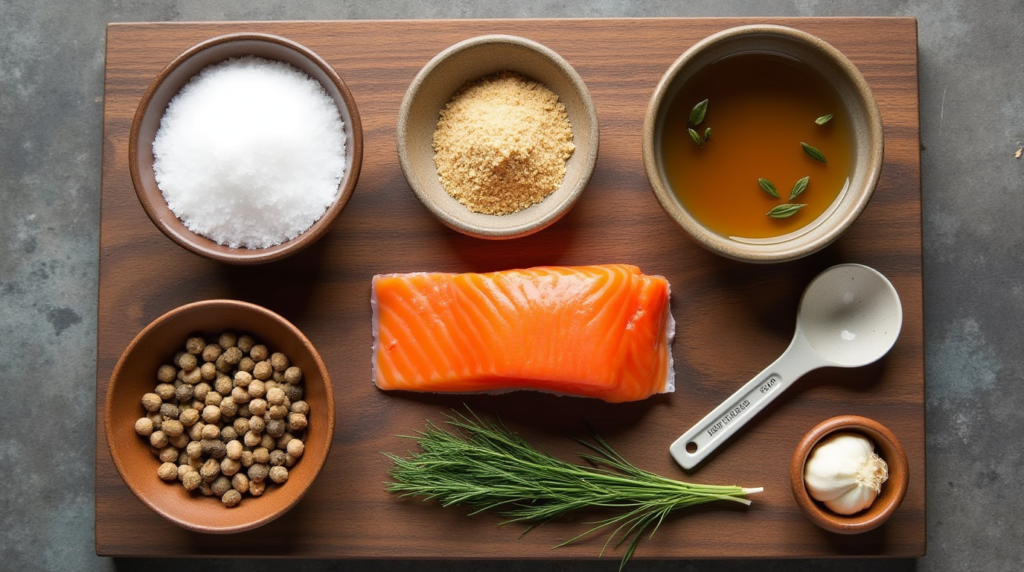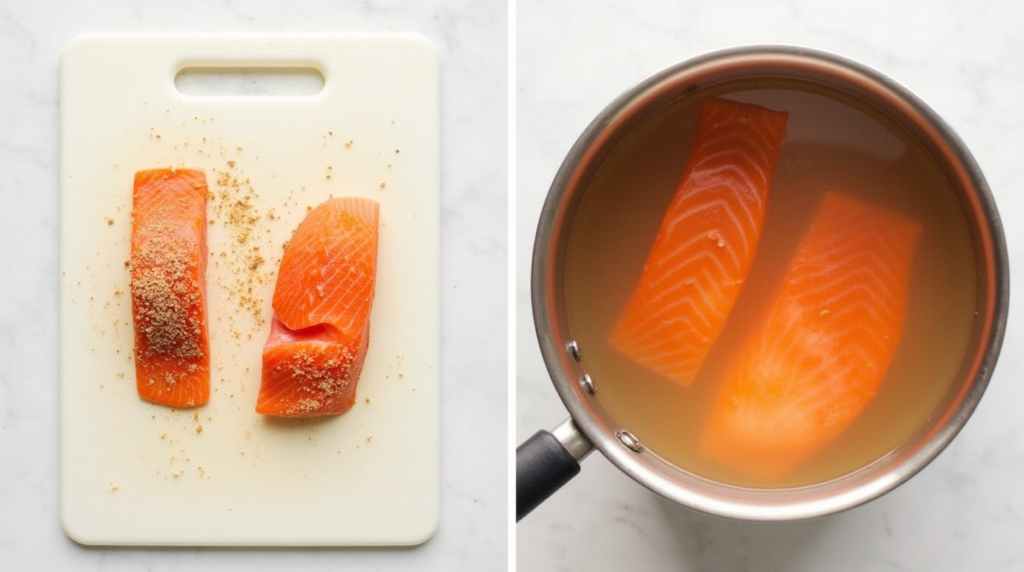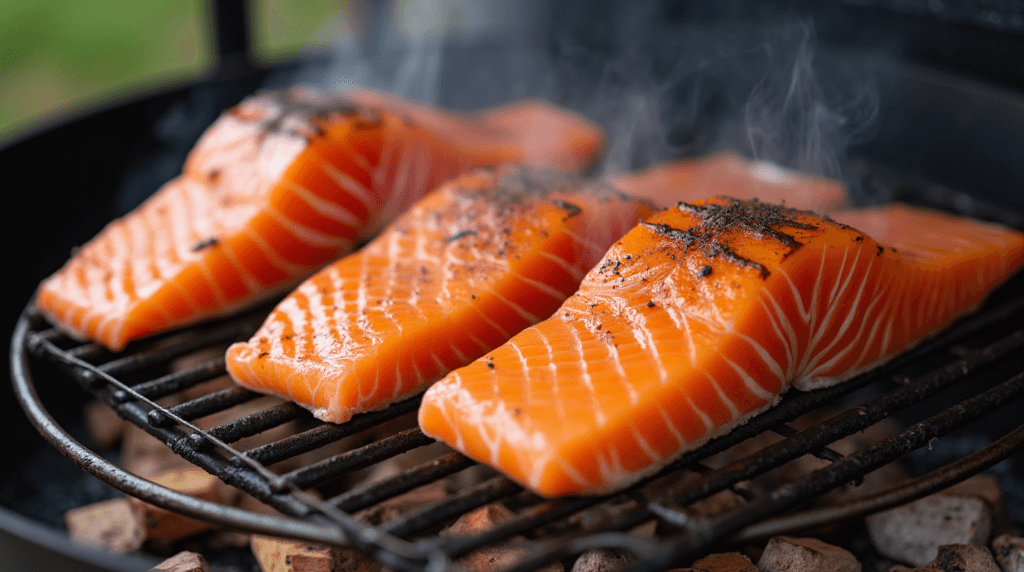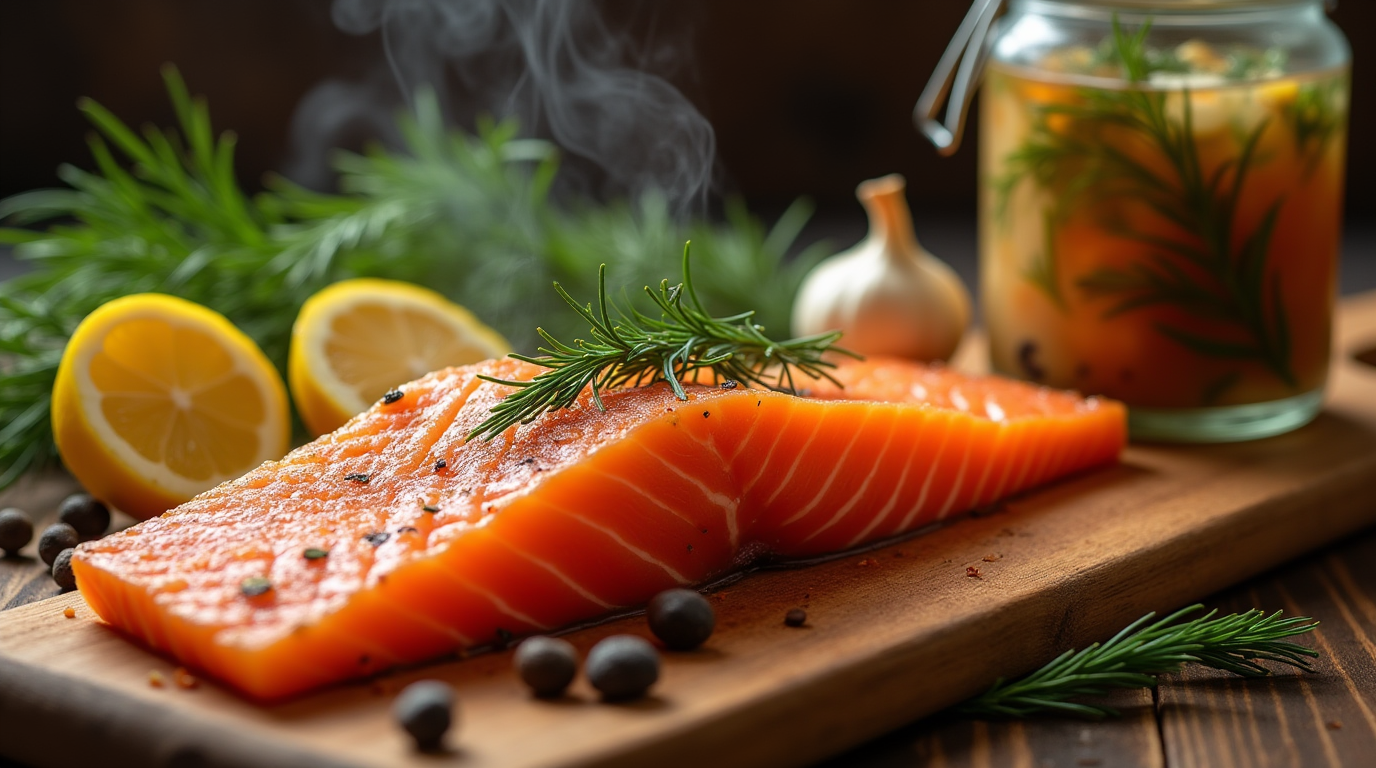Smoked Salmon Brine Recipe – Simple & Flavorful Prep Guide
Creating delicious Smoked Salmon Brine Recipe at home is easier than you think, and it all starts with a great brine recipe. A well-crafted brine is essential for bringing out the rich flavors and tender texture of the fish. By using a simple yet effective homemade brine, you can elevate your smoked salmon to the next level.
You’ll be guided through a straightforward process that ensures your salmon is perfectly prepared. With this guide, you’ll learn how to create a flavorful brine that complements the natural taste of the fish, resulting in a truly exceptional dining experience.
Key Takeaways
- Learn the importance of a good brine for smoked salmon.
- Discover a simple and effective homemade brine recipe.
- Understand how to prepare salmon for smoking.
- Elevate the flavor and texture of your smoked salmon.
- Follow a straightforward guide for a perfect brine.
The Art of Brining Salmon Before Smoking
To achieve the perfect smoked salmon, understanding the art of brining is essential. Brining is a process that involves soaking the salmon in a solution of water, salt, and sometimes sugar and other flavorings before smoking. This step is crucial for enhancing the flavor and texture of the salmon.
Why Brining Is Essential for Smoked Salmon
Brining is essential for smoked salmon because it helps to retain moisture and add flavor to the fish. The salt in the brine helps to break down the proteins in the fish, making it more tender and easier to digest. Additionally, brining allows you to infuse the salmon with various flavors, making it more delicious. A traditional smoked salmon brine often includes ingredients like brown sugar, maple syrup, and various spices.
How Brining Affects Flavor and Texture
The brining process significantly affects both the flavor and texture of the salmon. The salt and sugar in the brine penetrate the fish, enhancing its natural flavor. The texture is also improved as the proteins are broken down, making the salmon more tender. Here’s a comparison of the effects of brining on salmon:
| Characteristics | Before Brining | After Brining |
|---|---|---|
| Moisture Content | High | Retained and Enhanced |
| Flavor | Natural Fish Flavor | Enhanced with Brine Flavors |
| Texture | Soft | Firmer and More Tender |
Essential Ingredients for a Perfect Smoked Salmon Brine
Creating a perfect smoked salmon brine starts with understanding its essential ingredients. The quality and combination of these ingredients play a crucial role in the final flavor and texture of your smoked salmon.

Base Ingredients: Salt and Water
The foundation of any brine is salt and water. These two ingredients are crucial for creating an environment that enhances the flavor and texture of the salmon.
Types of Salt and Their Effects
The type of salt you use can significantly impact the flavor of your brine. Kosher salt and sea salt are popular choices due to their coarser texture and cleaner flavor compared to table salt. Kosher salt, for instance, has a milder flavor that won’t overpower the salmon.
Water Quality Considerations
Using good quality water is essential. Filtered water is recommended to avoid any impurities or additives found in tap water that might affect the brine’s quality.
Sweeteners: Brown Sugar, Maple Syrup, and Honey Options
Sweeteners balance out the saltiness of the brine and add depth to the flavor. Brown sugar is a classic choice, but you can also experiment with maple syrup or honey to introduce different flavor profiles. These sweeteners not only add sweetness but also contribute to the overall complexity of the salmon’s flavor.
Aromatics and Spices for Enhanced Flavor
Aromatics and spices are where you can get creative with your brine. Ingredients like black peppercorns, bay leaves, and dill can add a rich, complex flavor to your smoked salmon. You can also consider adding garlic or onion for an extra layer of flavor.
Equipment You’ll Need for Brining Salmon
To brine salmon like a pro, you’ll need a few key pieces of equipment. The right tools will make the process smoother and help you achieve the best results for your easy smoked salmon brine.
Containers and Storage Options
For brining, you’ll need a container that’s large enough to hold your salmon fillets completely submerged in the brine. A non-reactive container, such as stainless steel or food-grade plastic, is ideal. You can also use a large zip-top plastic bag or a brining bag specifically designed for this purpose. Make sure the container is clean and sanitized before use.
Measuring Tools and Additional Equipment
Accurate measurements are crucial for a successful brine. You’ll need measuring cups and spoons to mix your smoked salmon brine method ingredients correctly. A digital scale can be helpful for measuring larger quantities. Additionally, you’ll need a refrigerator to store the salmon while it brines. Some cooks also use a weight to keep the salmon submerged under the brine’s surface.
Selecting the Right Salmon for Smoking
To create an exceptional smoked salmon brine recipe, you need to start with the right salmon. The type of salmon you choose can significantly impact the flavor, texture, and overall quality of your final product.
Best Salmon Varieties for Smoking
Not all salmon varieties are created equal when it comes to smoking. King Salmon and Sockeye Salmon are highly prized for their rich flavor and firm texture, making them ideal for smoking. Atlantic Salmon is another popular choice, offering a more delicate flavor profile. When selecting salmon, look for fillets with a high fat content, as these will yield a more tender and flavorful smoked product.
Fresh vs. Frozen Considerations
When it comes to choosing between fresh and frozen salmon, both have their advantages. Fresh salmon can offer superior flavor and texture if handled properly. However, frozen salmon can be just as good, provided it was frozen correctly. Frozen salmon is often flash-frozen soon after catch, preserving its quality. If you’re not using the salmon immediately, frozen can be a good option. Just ensure you thaw it properly before using it for your smoked salmon brine recipe.
Classic Smoked Salmon Brine Recipe Step-by-Step
Creating a homemade smoked salmon brine is a straightforward process that requires just a few ingredients and some basic kitchen equipment. This step-by-step guide will walk you through measuring and mixing your brine, preparing your salmon, and the brining process itself.
Measuring and Mixing Your Brine
To start, you’ll need to measure out the ingredients for your brine. A basic recipe includes salt, sugar, and water, along with any additional flavorings you prefer, such as maple syrup or black pepper. Combine these ingredients in a bowl, stirring until the salt and sugar are fully dissolved.
The ratio of salt to sugar can be adjusted based on your personal taste preferences. For a classic brine, a 1:1 ratio is a good starting point. You can also add other ingredients like garlic, dill, or citrus zest to enhance the flavor.
Preparing Your Salmon
Before you can brine your salmon, you’ll need to prepare it. Rinse the salmon fillets under cold water, then pat them dry with paper towels. This helps the brine adhere to the fish more evenly.
If your salmon has a skin side, you can choose to leave the skin on or remove it, depending on your preference. For smoking, it’s often easier to work with skinless fillets.
Immersion and Brining Times
Once your brine is mixed and your salmon is prepared, it’s time to start the brining process. Place the salmon fillets in a container that allows them to be fully submerged in the brine. Cover the container and refrigerate.
The brining time will depend on the thickness of your salmon fillets. A general rule of thumb is to brine for 1 hour per inch of thickness. So, for a 1-inch thick fillet, you’d brine for 1 hour.
| Salmon Thickness | Brining Time |
|---|---|
| 1 inch | 1 hour |
| 1.5 inches | 1.5 hours |
| 2 inches | 2 hours |
Dry Brine vs. Wet Brine Methods Compared
Smoked salmon enthusiasts often debate the merits of dry versus wet brining, each method offering its unique advantages. Understanding these differences is crucial for achieving the perfect smoked salmon. The choice between dry and wet brining depends on your personal preference, equipment, and the flavor profile you’re aiming for.

Traditional Wet Brining Technique
The traditional wet brining technique involves soaking the salmon in a saltwater solution, often enhanced with sugar, spices, and aromatics. This method ensures the salmon remains moist and absorbs flavors evenly. To create a wet brine, you’ll need a container large enough to hold the salmon submerged in the brine solution.
A typical wet brine recipe might include a mix of salt, brown sugar, water, and various spices. The salmon is left to brine for several hours or overnight, depending on the recipe and the size of the fish. After brining, the salmon is rinsed and prepared for smoking.
Simple Dry Brining Alternative
Dry brining, on the other hand, involves rubbing the salmon with a mixture of salt, sugar, and spices, allowing it to sit in the refrigerator before smoking. This method is simpler and requires less equipment than wet brining. Dry brining can result in a more concentrated flavor on the surface of the salmon.
| Brining Method | Key Characteristics | Equipment Needed |
|---|---|---|
| Wet Brining | Salmon submerged in brine solution, moist and evenly flavored | Large container, refrigeration |
| Dry Brining | Salmon rubbed with dry brine mix, concentrated surface flavor | Refrigeration, minimal equipment |
Both methods can produce high-quality smoked salmon. Your choice between traditional smoked salmon brine and dry brining will depend on your specific needs and preferences. Experimenting with both smoked salmon brine methods can help you determine which works best for you.
Flavor Variations for Your Smoked Salmon Brine Recipe
Unlock the full potential of your smoked salmon by introducing bold and aromatic flavors into your brine. The classic smoked salmon brine can be transformed with a variety of ingredients, allowing you to customize the flavor to your liking.
Herb-Infused Brines
Infusing your brine with herbs can add a fresh and aromatic flavor to your smoked salmon. Consider using herbs like dill, parsley, or thyme to create a unique taste experience.
Dill and Fennel Combinations
A combination of dill and fennel can create a bright and refreshing flavor profile. The aniseed taste of fennel complements the freshness of dill, making it a perfect pair for smoked salmon.
Mediterranean Herb Blends
Mediterranean herbs like oregano, rosemary, and thyme can add a savory and slightly bitter taste to your smoked salmon. These herbs pair well with the richness of the salmon, creating a balanced flavor.
Citrus and Fruit Additions
Adding citrus or fruit to your brine can introduce a sweet and tangy element to your smoked salmon. Consider using lemon, orange, or grapefruit to create a refreshing flavor.
For example, a lemon and garlic brine can add a bright and savory flavor to your smoked salmon. Simply slice a lemon and add it to your brine along with some minced garlic.
Alcohol-Enhanced Brines
For a more complex flavor, consider adding a splash of alcohol to your brine. Whiskey, wine, or vodka can add depth and a unique character to your smoked salmon.
| Alcohol Type | Flavor Profile | Pairing Suggestions |
|---|---|---|
| Whiskey | Smoky, rich, and full-bodied | Pairs well with robust flavors like garlic and black pepper |
| Wine | Fruity, floral, and slightly acidic | Complements delicate flavors like dill and lemon |
| Vodka | Clean, crisp, and neutral | Works well with subtle flavors like salt and sugar |
By experimenting with different flavor variations, you can create a unique and delicious smoked salmon brine recipe that suits your taste preferences.
From Brine to Smoke: Preparing Your Salmon for the Smoker
With your salmon fully brined, it’s time to focus on the preparation steps that will lead to a perfectly smoked product. Proper preparation is crucial for achieving that tender, flavorful smoked salmon you’re aiming for.
Rinsing and Drying Techniques
After brining, gently rinse the salmon under cold running water to remove excess salt. Then, pat the salmon dry with paper towels, paying extra attention to the surface. This step is crucial for helping the salmon develop a good pellicle.
Developing the Pellicle
The pellicle is a sticky film that forms on the surface of the salmon, which helps the smoke adhere. To develop it, let the salmon air dry in the refrigerator for a few hours or overnight. This step is essential for achieving that rich, smoky flavor.
Seasoning After Brining
Once the salmon is dry, you can add additional seasonings if desired. Consider using a mix of black pepper, dill, and lemon zest for a classic flavor. Be gentle when applying the seasonings to avoid damaging the delicate flesh.
By following these steps, you’ll be able to prepare your salmon perfectly for smoking, resulting in a deliciously flavored final product.
Smoking Your Brined Salmon to Perfection
Now that your salmon has been brined, the next step is to smoke it to perfection, a process that demands careful consideration of several factors. Smoking is where the flavors you’ve developed during brining are enhanced, and the texture is transformed into a tender, flaky delicacy.

Temperature and Timing Guidelines
The key to smoking salmon lies in maintaining a consistent temperature between 225°F and 250°F. This range allows for a gentle cooking process that preserves the delicate flavor of the salmon. The smoking time will vary depending on the thickness of the salmon fillets, but a general rule of thumb is to smoke for about 30 minutes to 1 hour per inch of thickness.
It’s crucial to monitor the internal temperature of the salmon, aiming for 145°F to ensure food safety. Using a meat thermometer can help you achieve the perfect doneness without overcooking the fish.
Wood Selection for Optimal Flavor
The type of wood you choose for smoking can significantly impact the flavor of your salmon. Alder and maple woods are popular choices for smoking salmon, as they impart a mild, sweet flavor. For a stronger, more robust flavor, you might consider using woods like apple or cherry.
Testing for Doneness
To check if your smoked salmon is done, look for a firm texture and a slightly flaky appearance. You can also perform a simple flake test with a fork; if the salmon flakes easily, it’s ready. Additionally, checking the internal temperature, as mentioned earlier, is a reliable method to ensure doneness.
By carefully controlling the smoking process, you can achieve a perfectly smoked salmon that showcases the best smoked salmon brine recipe and smoked salmon brine method. The result is a deliciously flavored and textured dish that’s sure to impress.
Troubleshooting and Storage Tips
A well-crafted brine is just the beginning; understanding how to troubleshoot and store your smoked salmon is equally important. Whether you’re using a homemade smoked salmon brine or a classic smoked salmon brine recipe, issues can arise, and knowing how to address them will ensure a superior final product.
Common Brining Mistakes and Solutions
Brining mistakes can significantly impact the flavor and texture of your smoked salmon. Here are some common issues and their solutions:
- Over-brining, which can make the salmon too salty
- Under-brining, resulting in a lack of flavor
- Imbalanced flavors due to incorrect sweetener or spice levels
Over-Brining Problems
Over-brining occurs when the salmon is left in the brine for too long, absorbing too much salt. To avoid this, monitor the brining time closely, and rinse the salmon thoroughly before smoking.
Balancing Salt and Sweet Flavors
Achieving a balance between salt and sweet flavors is crucial. Adjust the levels of salt and sweeteners like brown sugar or honey in your homemade smoked salmon brine to suit your taste preferences.
Serving Suggestions for Your Smoked Salmon
Smoked salmon is versatile and can be served in various ways. Try pairing it with cream cheese on bagels, or with crackers and garnishes like capers and thinly sliced red onion. You can also incorporate it into salads or pasta dishes for added flavor.
Proper Storage and Shelf Life
To maintain the quality of your smoked salmon, store it in an airtight container in the refrigerator. It can last for up to a week when stored properly. For longer storage, consider freezing it, where it can last for several months.
Conclusion: Mastering Your Smoked Salmon Brine
Now that you’ve learned the intricacies of creating a perfect smoked salmon brine recipe, it’s time to put your knowledge into practice. By understanding the importance of brining, selecting the right salmon, and experimenting with various flavor variations, you can elevate your smoked salmon to the next level.
As you continue to refine your smoked salmon brine recipe, remember that practice makes perfect. Don’t be afraid to try new ingredients and techniques to find the combination that works best for you. With patience and persistence, you’ll be creating delicious smoked salmon that’s sure to impress.
By mastering your smoked salmon brine, you’ll be able to enjoy this delicious dish whenever you want, and you’ll have the confidence to experiment with new recipes and flavor profiles.
FAQ
What is the best type of salt to use for a smoked salmon brine recipe?
Kosher salt or sea salt are recommended for smoked salmon brine due to their mild flavor and coarse texture, which helps to evenly distribute the salt.
How long should I brine my salmon before smoking?
The brining time can vary depending on the thickness of the salmon and personal preference, but typically ranges from 1 to 4 hours.
Can I use a dry brine method instead of a wet brine for smoked salmon?
Yes, you can use a dry brine method, which involves rubbing the salmon with a mixture of salt, sugar, and spices, and then letting it sit in the refrigerator.
What are some common flavor variations I can try for my smoked salmon brine?
You can experiment with different flavor profiles by adding ingredients like citrus zest, herbs (such as dill or thyme), or spices (like black pepper or coriander) to your brine.
How do I know if my salmon is over-brined?
Over-brining can result in salmon that is too salty or has an unpleasant texture. Check your salmon periodically during the brining process to avoid over-brining.
What is the ideal temperature for smoking brined salmon?
The ideal temperature for smoking salmon is typically between 150°F to 200°F, with 175°F being a common target temperature.
How should I store my smoked salmon after it’s been prepared?
Smoked salmon should be stored in an airtight container in the refrigerator to maintain its freshness and prevent contamination.
Can I freeze smoked salmon, and if so, for how long?
Yes, you can freeze smoked salmon. It can be stored in the freezer for up to 3 months, but it’s best consumed within a month for optimal flavor and texture.
Leave a Review & Rate This Recipe!
There are no reviews yet. Be the first one to write one.

